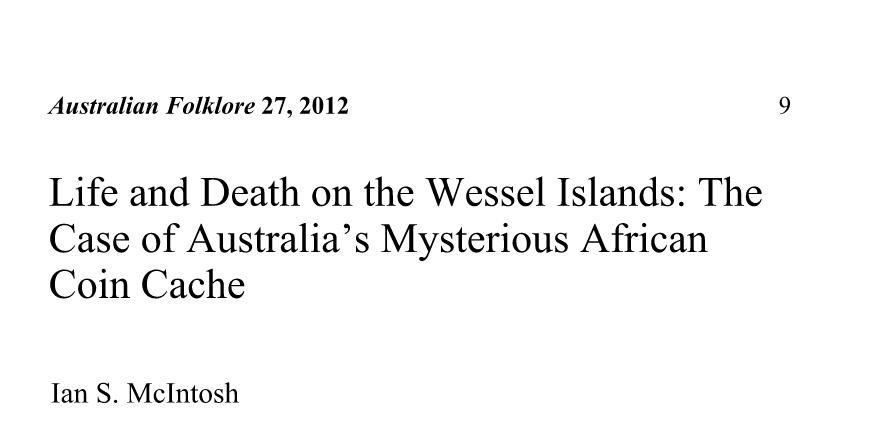The Wessel Coins #4: The Article November 18, 2013
Author: Beach Combing | in : Contemporary, Modern , trackbackThe Wessel Coins, for those who did not read earlier posts, were a series of medieval Kilwan coins (Kilwa = the east coast of Africa) and modern Dutch India Company coins that were found in 1944 on a beach on the Wessel Islands off the coast of northern Australia. Their presence in Australian sand, particularly the presence of Kilwan coins, came as something of a shock. Beach has now in his hands the article of Ian S. McIntosh (ref above), which lay behind the exploration and excavation of the area this summer. (We’ll come back in another post to progress made in the investigation). The earlier posts were, to some extent written blind without this article, and it is important (and instructive) to fill in some of the gaps in the story now that the article is to hand.
The article gives: background for the find in 1944; some sense of Yolngu history (the Aboriginal group traditionally associated with the Wessels); and sets out a list of credible candidates who could have brought the coins with them to this ‘furthest shore’. IM, in fact, offers five different groups as credible candidates: including Indonesians, ‘Sea Gypsies’ and the Portuguese. (Those who like their history really strange will be disappointed to see that Kilwans don’t figure!) IM also sees as important (as earlier commentators on this blog did) the fact that the two sets of coins were found together. Here is the description from a 1993 numismatic article by William Mira about Maurie Isenberg’s chance discovery:
One day, whilst fishing, [Maurie] saw four green circular objects lying in the sand, about one meter below the high water mark. He picked them up… and poked around in an area of about four square meters, finding five more. Having no interest in coins at the time, he … put [the coins] in an airtight match tin; this went into his kit bag and returned with him to [Australia].
Now the three Kilwan coins dates from 900s-1300s, but the six Dutch coins date from 1690s to the 1790s: to put this in some kind of perspective the first European ship arrived (that we know of) in the Wessel Islands in 1623. If all nine really were associated then the hoard as a whole must date to the later eighteenth century at the earliest. IM pretty much takes for granted that they are associated and unless there was a big problem with Maurie’s memory (?) then IM is probably right to do so. His explanation is that they have to do with trepanging: the search for trepangs or sea cucumbers that begins at this date; trepangs had huge market values far to the north. If this was, indeed, the case then the coins will have been a mélange of worthless spare change given by Makassar fishermen to the locals as ‘baubels’. So far this is very credible and the dates tie up rather neatly: serious trepanging, carried out by fishermen from the north, seems to have begun properly in the 1780s.
However, IM pushes the boat out a little further, albeit very tentatively. Yolngu oral tradition tells us that a Makassar named Buthimang lived on this part of the island about a century later in the mid 1800s. IM very gently suggests that ‘outsider’ coins may have been entrusted to him as an outsider (though one who had partially accepted into Yolngu society) and that they were lost when he died or in some accident such as a storm. If this was the case, then, the association of the Dutch coins and the Kilwan coins may be a nineteenth-century fact and our late date for the Kilwan coins is suddenly exploded: in other words the hoard did have a unity, but Buthimang was entrusted with all ‘outsider’ coins, which had been picked up by the locals at different times.
Of course, all this begs another question. How did the Makassars get their hands on Kilwan coins (if it was them who brought the coins south)? Here IM makes a suggestion that came as a bit of shock to this blogger.
The relative newness in appearance of the Kilwa coins suggests that they may have been minted outside of Kilwa, perhaps in the Islamic ports of south-east Asia as curiosity items or even as talisman….
Not sure what the proof would be for this and even if they had been minted freshly then there would have been a model. It should be remembered at this point that (i) Kilwa became Portuguese and was reportedly littered with low-value coins and (ii) the furthest east one of these coins has been previously found is Oman. Make of those two facts what you will.
A fascinating case investigated in an exemplary fashion. Next summer there will hopefully, funding allowing, be a new expedition: fingers crossed.
Further thoughts on the Wessel Mystery? drbeachcombing AT yahoo DOT com



